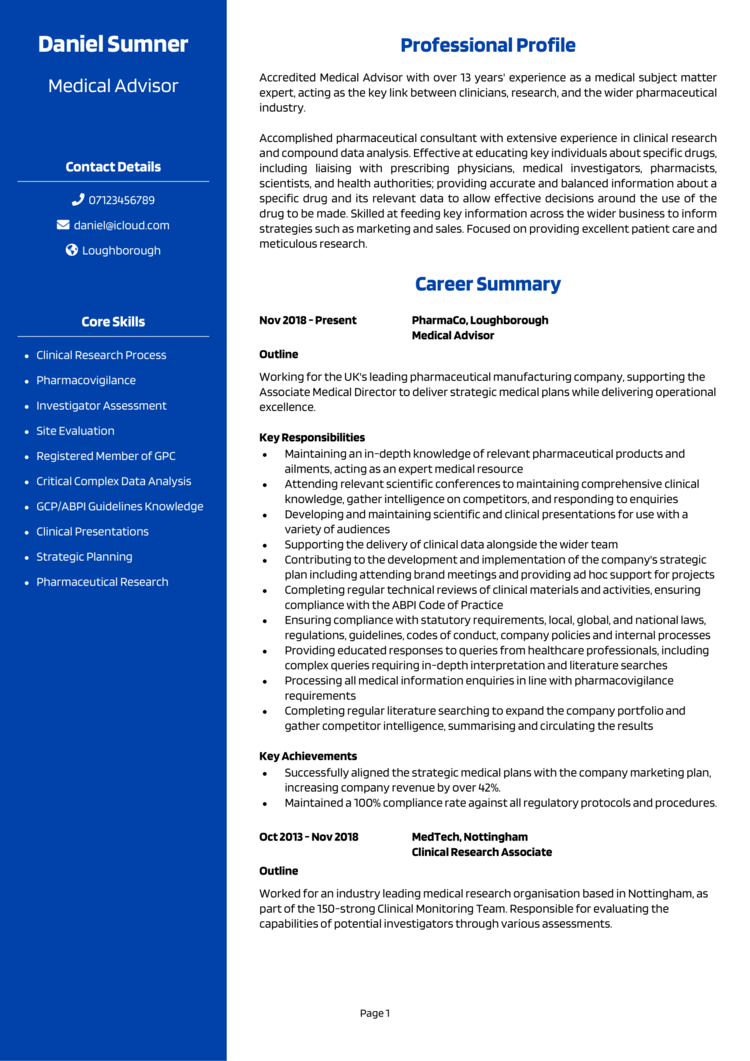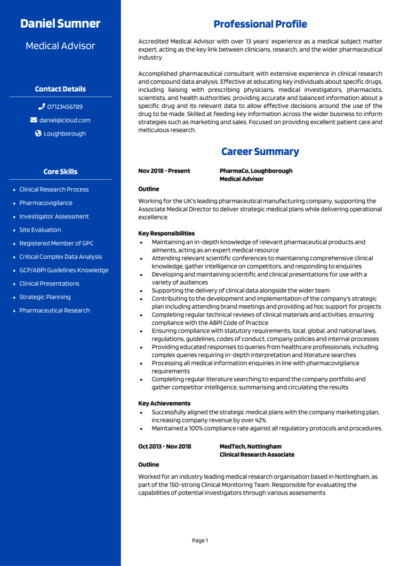Every decision you make is backed by evidence, every recommendation carefully weighed against the latest research. That same precision is exactly what’s needed when putting together your CV – and your odds of landing a job depend on how well you can do this.
This guide and its Medical Advisor CV example will show you how to present your expertise, qualifications, and professional impact in a way that catches a recruiter’s attention and makes you a strong contender for any Medical Advisor position.
Medical Advisor CV sample

How to write your Medical Advisor CV
Discover how to craft a winning Medical Advisor CV that lands interviews with this simple step-by-step guide.
In healthcare and medical consultancy, clarity and precision are vital – so your CV should follow the same principles. By structuring your application effectively and presenting your experience in the most relevant way, you make it easy for recruiters to recognise your value immediately.
Here, you’ll find step-by-step guidance on writing a CV and tailoring it to highlight the achievements and the expertise that makes you a standout candidate.
The best way to structure and format your Medical Advisor CV


When recruiters and hiring managers can locate key information quickly, they’re far more likely to engage with your application and shortlist you for an interview. Therefore, it’s important that your CV is as clear and easy to interpret as any good medical report. You’ll want to structure information in a nice, readable way.
Here’s the layout to follow:
- Name and contact details – Start with your name and personal details – make it simple for recruiters to reach you. Including a photo is a personal choice.
- Profile – Use this section to summarise your experience, strengths, and what makes you a standout candidate.
- Core skills – Outline your primary competencies to give recruiters a snapshot of your strengths.
- Work experience – Walk through your professional experience, beginning with your latest position and moving backwards.
- Education – Outline your education and certifications, focusing on those most relevant to the role.
- Additional info – This section is optional, but it’s a good place for interests or hobbies that complement your CV.
When formatting, keep your document professional and easy to navigate. Use bullet points in each section to make key information stand out, and divide sections with clear headings. Choose a clean, readable font, keep the CV length to two pages or less, and make use of white space so your content is easy on the eye.
What is a Medical Advisor CV profile?


Your CV profile is the first opportunity to show employers why you’re the Medical Advisor they need. Use it to summarise your background, highlight the scope of your expertise, and emphasise the benefits you can offer – anything from your track record improving patient outcomes to your ability to advise on product safety and efficacy.
Make it clear how your work drives results and adds value: ideally, you’ll immediately impress recruiters enough for them to read the rest of your CV more thoroughly.
Medical Advisor CV profile examples
Profile 1
Experienced Medical Advisor with over 15 years in the pharmaceutical and healthcare sectors, providing scientific and clinical expertise to support product development and medical strategy. Skilled in interpreting clinical trial data, preparing regulatory submissions, and delivering training to commercial teams. Proficient in using CRM systems, MedDRA, and literature review databases. Recognised for building strong relationships with healthcare professionals and ensuring medical accuracy in all communications.
Profile 2
Knowledgeable Medical Advisor with eight years of experience in oncology and rare disease therapy areas. Supported cross-functional teams by reviewing promotional materials, managing investigator-initiated studies, and providing insights from key opinion leaders. Adept at using Veeva Vault, PubMed, and statistical analysis tools to support evidence-based decision-making. Known for ensuring compliance with ABPI and global regulatory standards.
Profile 3
Motivated Medical Advisor with three years of experience in a pharmaceutical start-up, supporting early-stage clinical programmes and medical information services. Assisted in preparing slide decks, FAQs, and training resources for internal teams. Comfortable working with databases, reviewing safety data, and supporting cross-border collaborations. Passionate about applying medical knowledge to ensure patient safety and effective communication of scientific information.
Details to put in your Medical Advisor CV profile
Here’s what you should aim to include:
- Where you worked – Indicate the settings you’ve worked in, whether within pharmaceutical companies, healthcare providers, or research organisations.
- Your top qualifications – Mention relevant medical degrees, specialist training, or industry certifications that reinforce your authority.
- Essential skills – Outline your core professional strengths, keeping them closely aligned with the job requirements.
- Specialist areas or focus – Highlight any therapeutic areas, regulatory expertise, or clinical specialisms you have worked in.
- Value delivered – Explain how your work has supported safe practice, informed strategy, or improved operational effectiveness.
How to highlight your core skills


Your core CV skills section acts as a quick reference point for recruiters. It’s often one of the first places they look to confirm you have the competencies they’re seeking.
Keep this section focused on tangible, measurable skills that match the job description. Avoid vague or generic terms, and instead ensure every point reflects an ability that can be backed up by your experience. Tailor it to each application to show you’ve paid attention to the specific requirements of the role.
Essential skills for a Medical Advisor CV
- Clinical Guidance and Expertise – Providing accurate medical input to support product development, marketing, or healthcare decisions.
- Regulatory and Compliance Knowledge – Ensuring that all medical communications and activities meet industry regulations and ethical standards.
- Scientific Literature Review – Analysing and interpreting clinical research to inform internal strategy and external communications.
- Medical Information Support – Responding to queries from healthcare professionals with up-to-date, evidence-based information.
- Cross-Functional Collaboration – Working with regulatory, commercial, and marketing teams to align messaging with clinical integrity.
- Product Training and Education – Delivering medical training to internal teams and external stakeholders on therapeutic areas and products.
- Clinical Trial Support and Oversight – Assisting in the design, review, and monitoring of clinical studies and real-world evidence collection.
- Medical Writing and Content Review – Creating and reviewing materials such as slide decks, publications, and promotional content for accuracy.
- KOL Engagement and Advisory Boards – Building relationships with key opinion leaders to gather insights and ensure scientific alignment.
- Pharmacovigilance and Safety Monitoring – Supporting the review and reporting of adverse events in compliance with safety protocols.
How to showcase your work experience in your CV


Your work experience is where you demonstrate the application of your knowledge and skills in real-world scenarios. Employers want to see how you’ve influenced decisions, solved problems, and delivered results as a medical advisor.
Present your roles in reverse chronological order, starting with your most recent. For each one, give a short summary of your position and the organisation before breaking down your responsibilities and achievements into bullet points.
How to format previous jobs in your CV correctly

- Outline – Describe the organisation and its focus, your role within it, and the purpose of your position, including who you reported to.
- Responsibilities – Detail your core duties, using action words like “advised” and “reviewed.” For example: “advised on regulatory compliance” or “reviewed clinical trial documentation for accuracy.”
- Achievements – Demonstrate measurable impacts, such as improving efficiency, ensuring compliance, or contributing to successful project outcomes.
Example work history for Medical Advisors
Medical Advisor | Harrington Pharmaceuticals
Outline
Provided medical and scientific support for a global pharmaceutical company specialising in cardiovascular treatments. Worked closely with commercial, regulatory, and R&D teams to ensure accurate and compliant medical content.
Responsibilities
- Reviewed promotional and non-promotional materials for compliance with ABPI Code
- Provided medical training for sales representatives and commercial teams
- Monitored and interpreted clinical trial data to provide strategic insights
- Supported investigator-initiated study applications and scientific collaborations
- Responded to medical information queries from healthcare professionals
Achievements
- Contributed to a successful product launch achieving £100m sales in the first year
- Reduced review turnaround time by 25% through process optimisation
- Built relationships with 50+ key opinion leaders to strengthen medical engagement
Medical Advisor | Nexora Biotech
Outline
Supported medical affairs activities for a biotechnology company specialising in oncology therapies. Collaborated with clinical development teams, regulatory authorities, and external stakeholders to align medical strategy with business goals.
Responsibilities
- Reviewed scientific literature and prepared evidence summaries for internal teams
- Provided input into clinical trial design and protocol development
- Monitored safety data and contributed to pharmacovigilance reports
- Organised advisory boards and scientific meetings with external experts
- Supported regulatory submissions with clinical and medical documentation
Achievements
- Helped secure EMA approval for a breakthrough oncology therapy
- Authored two peer-reviewed publications on treatment outcomes
- Increased medical affairs efficiency by 30% by introducing new data review tools
Medical Advisor | Brightvale Therapeutics
Outline
Worked as part of the medical affairs team at a start-up specialising in rare diseases. Assisted with medical information services, early clinical development support, and internal training programmes.
Responsibilities
- Prepared slide decks, FAQs, and briefing documents for internal use
- Reviewed safety data and contributed to risk-benefit assessments
- Responded to enquiries from healthcare professionals with accurate scientific data
- Supported cross-functional meetings with regulatory and commercial teams
- Contributed to pipeline development research and competitor landscape analysis
Achievements
- Assisted in the successful filing of an orphan drug designation application
- Reduced medical enquiry response times by 40% through standardised templates
- Supported first-in-human trial initiation by coordinating medical documentation
Structuring your education section


While hands-on experience is crucial, your education will form the backbone of your credibility. Include your medical degrees, any specialist training, and certifications that strengthen your authority as an advisor.
List these in reverse chronological order, starting with your most recent qualification. If relevant, include ongoing professional development courses to show commitment to staying current in your field.
Top qualifications to showcase on a Medical Advisor CV
- Medical Degree (MBBS or equivalent) – Establishes core clinical competence.
- Specialty Training Certificate – Demonstrates advanced expertise in a relevant medical field.
- Postgraduate Diploma in Pharmaceutical Medicine – Supports work within pharma and research sectors.
- Good Clinical Practice (GCP) Certification – Shows compliance with ethical and regulatory standards.
- Health and Safety in the Workplace Certificate – Confirms understanding of safety protocols in clinical and corporate settings.





